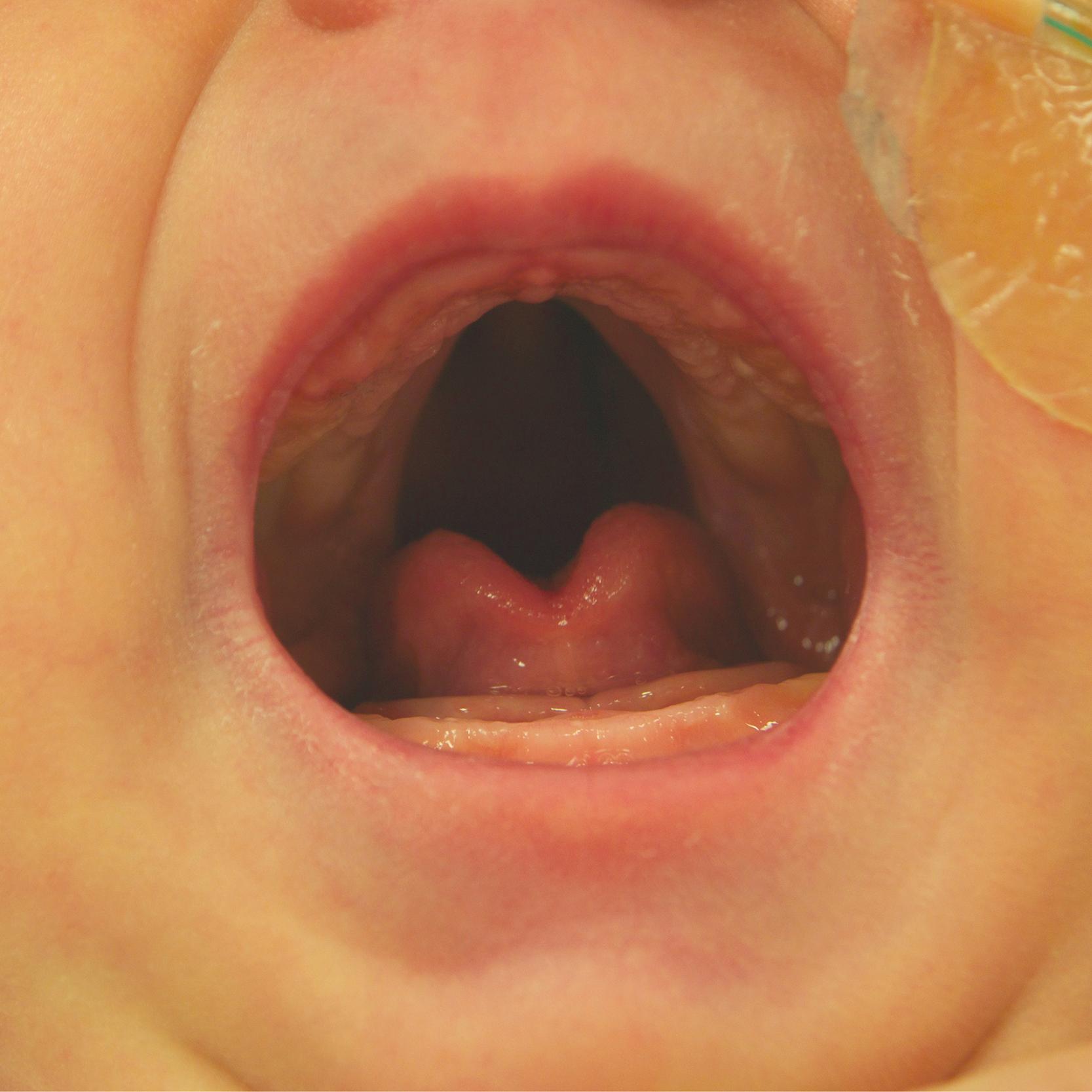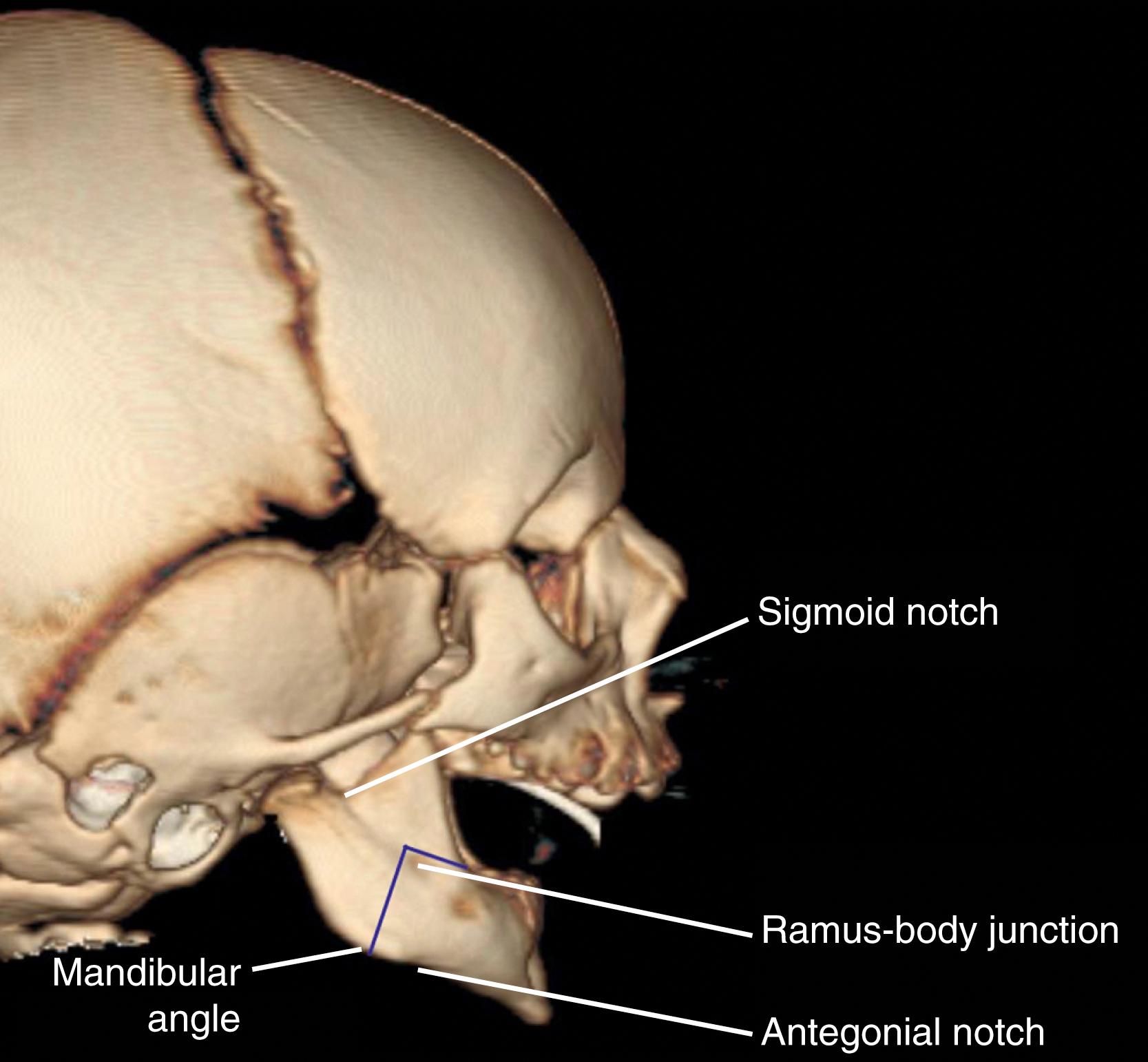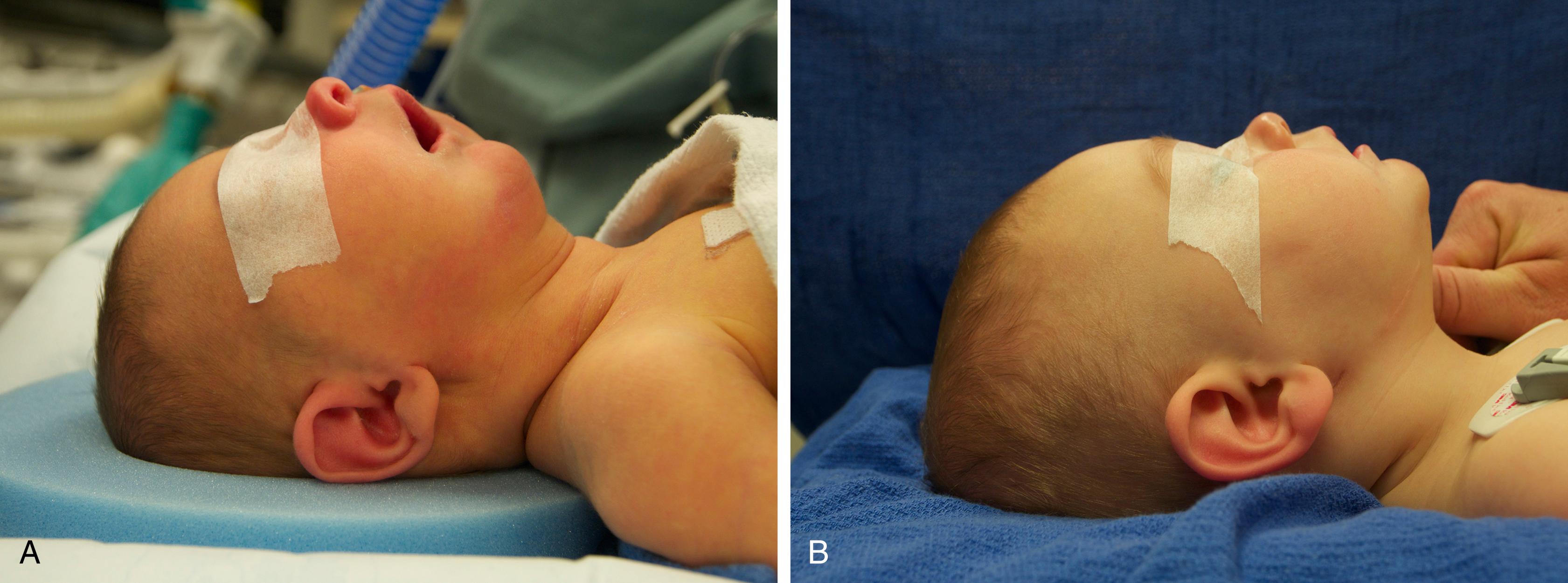Physical Address
304 North Cardinal St.
Dorchester Center, MA 02124
The classic Pierre Robin sequence (PRS) refers to a constellation of physical findings characterized by microretrognathia and glossoptosis; cleft palate is an associated feature but is not required for the diagnosis of PRS. The posterior displacement of the base of the tongue functionally obstructs the airway, causing apnea, stridor, difficulty with feeding, and retarded growth. The clinical severity of this obstruction can range from subtle hypopneas, which may be noted only on a sleep study, to dramatic life-threatening respiratory compromise that requires emergent airway intervention.
Initial nonsurgical management of tongue-base-related obstruction includes prone positioning and placement of a nasopharyngeal airway. However, these measures may complicate already tenuous feedings and may increase the risk for sudden infant death in an unmonitored setting. Tongue-base-related obstruction has traditionally been surgically addressed by tracheostomy to bypass the obstruction. However, this carries a low, but real risk of mortality from mucous plugging and other airway compromise. For this reason, other surgical options, including tongue-lip adhesion (TLA) were developed to address the retrodisplacement of the tongue. However, high rates of dehiscence, feeding difficulties, and recurrence of obstruction have been reported.
Mandibular distraction osteogenesis (MDO) has gained popularity as a treatment to address the underlying microretrognathia, which leads to tongue base collapse. While distraction osteogenesis was developed in the 1920s by a Russian orthopedic surgeon, it was not adapted for use in the mandible until the 1990s, and was not applied to neonatal patients with PRS until more recently. Since then, several studies have demonstrated objective improvement in both feeding and airway measures, including reduced apnea-hypopnea index, relief of hypoxemia and hypercapnia, and increased rates of per oral nutrition. MDO also has been successfully used to alleviate airway obstruction in patients with other causes for tongue base collapse, including neurologic impairment.
As microretrognathia and glossoptosis occur in a spectrum from mild to severe, careful history taking, physical examination, and preoperative planning is necessary to identify patients who may benefit from MDO.
Patients with PRS are best treated by an interdisciplinary team, including Pediatric Otolaryngologists, Surgeons trained in craniofacial surgery, Neonatal Intensivists, Pulmonologists, Geneticists, and Speech-Language Pathologists.
The diagnosis of PRS is made clinically when microretrognathia and glossoptosis are detected. The normal difference between the maxillary and mandibular arches is usually less than 5 mm. In most infants with PRS requiring airway intervention, this distance of maxillary overjet resulting in class II occlusion is often greater than 10 mm.
A full airway evaluation prior to, or coordinated with, MDO is prudent as secondary airway lesions, such as laryngomalacia, subglottic stenosis, or tracheomalacia, are common.
Careful handling of soft tissue during access to the infant mandible is essential in avoiding iatrogenic nerve injury.
Co-linear vectors are important to maintaining symmetric distraction.
History of present illness
It is important to take a careful birth history, including prenatal diagnosis by ultrasound or eliciting any complications with pregnancy or delivery.
Birth history should also include any initial airway distress and need for airway intervention, including prone positioning, nasopharyngeal airway, or intubation.
Any symptoms of airway distress including stridor, increased work of breathing, cyanosis, or acute life-threatening events (ALTEs) should be discussed.
If the infant is feeding orally, the parents should be asked about a typical feeding, including the quantity of feeds, the duration of each feeding, and any concerns for aspiration. Decreased volumes or increased time for feeding may indicate a problem with the coordination of breathing and swallowing.
Past medical history
A careful review of the birth history, initial hospitalization, previous evaluations, and interventions to address airway and feeding concerns should be undertaken.
Any ALTEs or cardiopulmonary arrests should be discussed.
Other medical issues, congenital anomalies, or known genetic diagnosis should be reviewed.
Examination of the airway
Observation of the infant breathing at rest may reveal signs of stridor or stertor, nasal flaring, subcostal or suprasternal retractions.
Flexible nasolaryngoscopy may be performed at the bedside to assess the patency of the choanae bilaterally, laryngomalacia, and degree of tongue base collapse. Due to the very stimulating nature of the examination, bedside laryngoscopy likely significantly underestimates the degree of tongue base collapse that exists while the patient is sleeping,
Examination of the palate ( Fig. 202.1 )
A cleft palate is often associated with PRS, but it is not always present and is not essential for the diagnosis. Varying degrees of orofacial clefting can be seen with PRS from a normal palate to a bilateral complete cleft lip and palate. However, a Veau I or Veau II cleft palate is often noted.

Examination of the mandible
Measurement of the discrepancy between the central portion of the maxillary alveolar process and the mandibular alveolar process can be made easily by placing the wooden end of a cotton-tipped applicator along the anterior edge of the mandibular gingiva in the midline. The patient can then be placed into occlusion. The maxillary gingiva will then touch the wooden applicator, creating a natural marking on the wood due to saliva. However, if this is unclear, then markings may be made by pinching with two fingers or by a marking pen. The distance from the tip of the applicator to the marking indicates the degree of maxillary overjet. The upper limit of normal is considered to be 5 mm. Care must be taken to avoid posterior pressure on the mandible, which can cause retropositioning of the mandibular condyle out of the immature glenoid fossa, thereby accentuating the maxillary-mandibular discrepancy.
Mandibular asymmetry should be assessed to evaluate for hemifacial microsomia.
Craniofacial examination
All patients with suspected PRS should undergo a thorough craniofacial exam ination to evaluate for common accompanying syndromic diagnoses. Evaluation of the shape of the head can identify co-existing craniosynostosis. Orbital morphology can help distinguish Stickler syndrome, 22q deletion syndrome, or Treacher-Collins/Nager syndrome. Malar projection should be noted as should any anomalies of the ear, including microtia, pre-auricular remnants, or branchial arch anomalies. Assessment of the maxillary projection is critically important. Patients with significant maxillary hypoplasia may demonstrate minimal maxilla-mandibular discrepancy despite having severe micrognathia.
Computed tomography (CT): a craniofacial CT including 3D reconstructions is carried out in advance of surgery for preoperative planning of osteotomy sites and placement of the distractor ( Fig. 202.2 ).

Patients with tongue base collapse due to microretrognathia who demonstrate signs of airway obstruction by increased work of breathing, desaturation, hypoxemia, hypercapnia, or obstructive sleep apnea on polysomnogram.
Patients with tongue base collapse due to microretrognathia who have been intubated and are not able to be safely extubated due to their severe microretrognathia.
Patients with an existing tracheostomy who cannot be successfully decannulated due to microretrognathia and tongue base obstruction.
Medical co-morbidities with increased risk for general anesthesia.
Significant secondary airway lesions that cannot be addressed without tracheostomy.
Severe central sleep apnea. In patients with mixed apnea, it has been demonstrated that many of the central apneic events noted on sleep studies improve after resolution of the obstructive component. However, patients with severe central sleep apnea or central hypoventilation will require positive pressure ventilation and should be considered for a tracheostomy.
Photo-documentation ( Fig. 202.3 )

Polysomnogram
Bedside nasolaryngoscopy
Flexible sleep endoscopy and rigid laryngoscopy and bronchoscopy
CT scan of mandible with 3D reconstruction
Become a Clinical Tree membership for Full access and enjoy Unlimited articles
If you are a member. Log in here